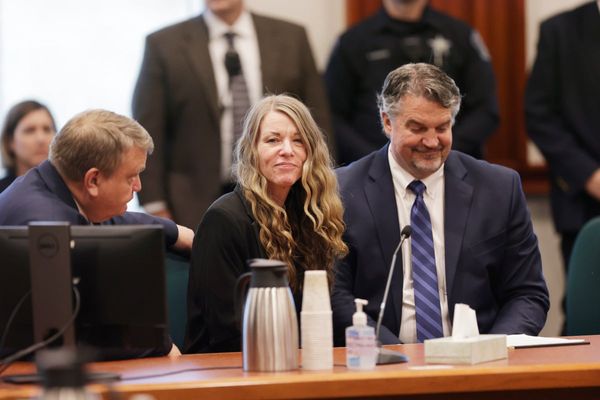College football fanatics tuned in Saturday for the latest edition of the iconic Red River Rivalry between Texas and Oklahoma on ABC.
Unfortunately, actually watching the game proved to be a bit more challenging.
Throughout the first quarter of the rivalry tilt, ABC—the network broadcasting the game in conjunction with ESPN—experienced several disruptions. Both the video feed and the audio from the announcing crew of Chris Fowler and Kirk Herbstreit fizzled at times, often at critical moments early in the contest.
Certainly the worst example of the spotty broadcast came when the Longhorns ran a fake punt from within their own territory on their second possession of the game. Much of the play was lost on television as viewers saw a mostly black screen instead.
The Oklahoma-Texas ESPN on ABC broadcast has been full of technical difficulties, including right in the middle of this fake punt from the Longhorns. 🏈📺😵💫 pic.twitter.com/7YffxdHQ6h
— Awful Announcing (@awfulannouncing) October 7, 2023
Shortly afterward, on the same Texas drive, Fowler offered an apology to the television audience, vowing that the broadcast crew was doing everything it could to remedy the situation.
“We apologize. We’re rolling with some serious technical issues …” Fowler said. “It’s a power issue … Our crew is as good as any trying to get things in terms of the cameras and microphones back up and running.”
"We apologize; we're dealing with some serious technical issues (on this Oklahoma-Texas ESPN on ABC broadcast)... It's a power issue. Our crew is as good as any trying to get things in terms of the cameras and microphones back up and running."- Chris Fowler pic.twitter.com/r0VW3eFh07
— Awful Announcing (@awfulannouncing) October 7, 2023
ESPN issued a statement explaining that initial technical issue.
“There was a brief power issue at the Cotton Bowl that impacted our field equipment and on-site generator early in the game. It was quickly resolved,” the network said, per Sportico’s Jacob Feldman.
Additionally, ABC and ESPN currently are dealing with another issue that can impact broadcast quality: the sun. Seriously.
This week, the Earth and Disney (which owns ABC and ESPN) company satellites are positioned in a direct line with the sun. The rare occurrence happens twice a year, and it can lead to outages because the sun can overpower the radio frequency energy transmitted by satellites down to Earth.
In 2014, Brian Burney, traffic manager for ESPN’s remote traffic operations, explained how the company tries to counteract the phenomenon and avoid major disruptions on broadcasts.
“Planning begins 4-to-6 weeks prior to each outage period. Remote Traffic Operations utilizes a software program that will predict when each satellite will incur a sun outage,” he explained. “The report allows our team to analyze each live event backhaul and determine if we need to make alternate arrangements so that we can bring the feed into Bristol [Conn., ESPN’s headquarters] uninterrupted.
“Once the outage is complete, the operators will switch back to the original satellite source to the conclusion of the event. It is a collective effort involving many different areas within our company to protect our product and the fan experience.”
Though it seems there’s just about nothing ABC or ESPN could do but weather the storm, college football fans and media members couldn’t stand missing out on part of an eventful first half in Dallas.
ABC YOU RUINED THE FAKE PUNT 😡😡😡
— RedditCFB (@RedditCFB) October 7, 2023
Happy Disney sun outage day, everyone pic.twitter.com/mqjemVbYrQ
— Timothy Burke (@bubbaprog) October 7, 2023
the ABC broadcast has been worse than Quinn Ewers today pic.twitter.com/yWMFoDcnky
— wow that was crazy (@CowardlyDoggo) October 7, 2023
Just so I’m not going insane… Anyone else seeing satellite issues with their ABC feed?
— Curtis Fitzpatrick (@cfitzfox) October 7, 2023
Can ABC figure this shit out
— Burnt Orange Nation (@BON_SBNation) October 7, 2023
fix the broadcast @ABC
— charles (“you look good” - andy reid) mcdonald (@FourVerts) October 7, 2023
it'd be swell if ABC could get their broadcast act together pic.twitter.com/ucb8ergOf1
— Jon Hamm (@JonMHamm) October 7, 2023
This ABC broadcast is not a good preview of the SEC on ABC starting next year.
— /r/LonghornNation (@rLonghornNation) October 7, 2023
ABC and ESPN broadcast teams are having one of the worst spats of technical difficulties I’ve seen in a while. This broadcast is almost unwatchable 😭
— Connor Putman (@ConnorPutt) October 7, 2023







